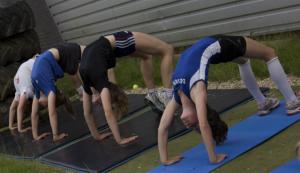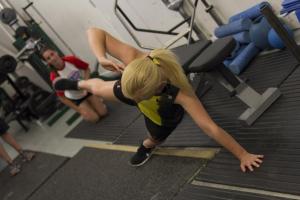Athletic Movement: 8 tips on how to move like an athlete.
Or why you should avoid exercise machines!
 Here are some thoughts on the training of athletic movement gained from recent reflections/ reading or coaching. In no particular order:
Here are some thoughts on the training of athletic movement gained from recent reflections/ reading or coaching. In no particular order:
- Get athletes to move from slow to fast to slow again. Watch how some movement is easier at slow speed, some at fast. If they can do this fluidly, things are going well. If they struggle, more work is needed on the transition.
-
Flexibility is more than stretching: it is how you move from position to position. No amount of stretching can compensate for your incorrect exercise technique. Link a series of stretches together and work on the transition, combine this with breathing and you will get results that transfer to your sport.
James showing some flexibility in movement
- “One should seek good balance in movement, not stillness“ Steve Myrland: like the flexibility, it is the ability to move around from position to position that is important.
- Prescriptive sessions can set the fundamentals up for athletes; you teach them how to stand, crawl, roll, jump, hop, skip, run, bounce, glide and soar. However, true learning occurs when they have problems to solve that require linking and syncing of those athletic movement patterns. Allow time for them to do it on their own, in pairs and finally as a group.
- Balance and movement can be challenged by using 1,2,3 or all 4 limbs. Alternate between them.
- “Complex equipment tends to yield simplistic results, simple equipment tends to yield complex results” Steve Myrland. There appears to be an inverse relationship between “gadgets or stuff” and sound coaching. I have seen hundreds of “agility” sessions that have tons of cones, ladders or poles set up, but have little impact on improving agility. If you fail to project your hips in the direction of travel, you are just rehearsing bad mechanics.
- Extension, brachiation (hanging) and inversion need to be included in every training session because gravity is crushing us at every opportunity.
 “The core is a human construct, not a physiological construct” Lederman. If your coach is getting you to do “core” training consisting of the plank: sack them and get a new one!
“The core is a human construct, not a physiological construct” Lederman. If your coach is getting you to do “core” training consisting of the plank: sack them and get a new one!
The human body is designed to move, that includes the “core”. The ability to brace is essential, but do that in the context of movement around a central point. Once you can hold all 4 plank positions for 15 secs, it is time to move. Watch this healthy shoulder exercise video to see how to progress from the plank:
- More on this in our coaching courses
- Join our club and improve your athletic movement

Absolutely key advice as related to the sport of Squash. Far too much emphasis in our sport is Shot-centric instead of Rally-centric which leads to isolation of individual behaviors and a lack of flow. Excellent advice for all Squash athletes and students of the game here.
Richard Millman
Thanks Richard. I agree about the sequencing of movements, based on sound fundamentals.
[…] 8 tips on how to move like an athlete […]
[…] 8 Tips on how to move like an athlete […]
[…] Top 8 tips to move like an athlete […]